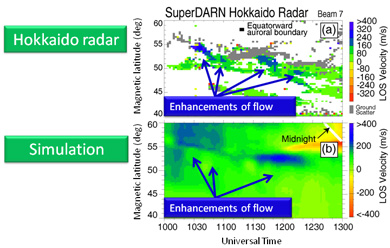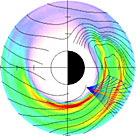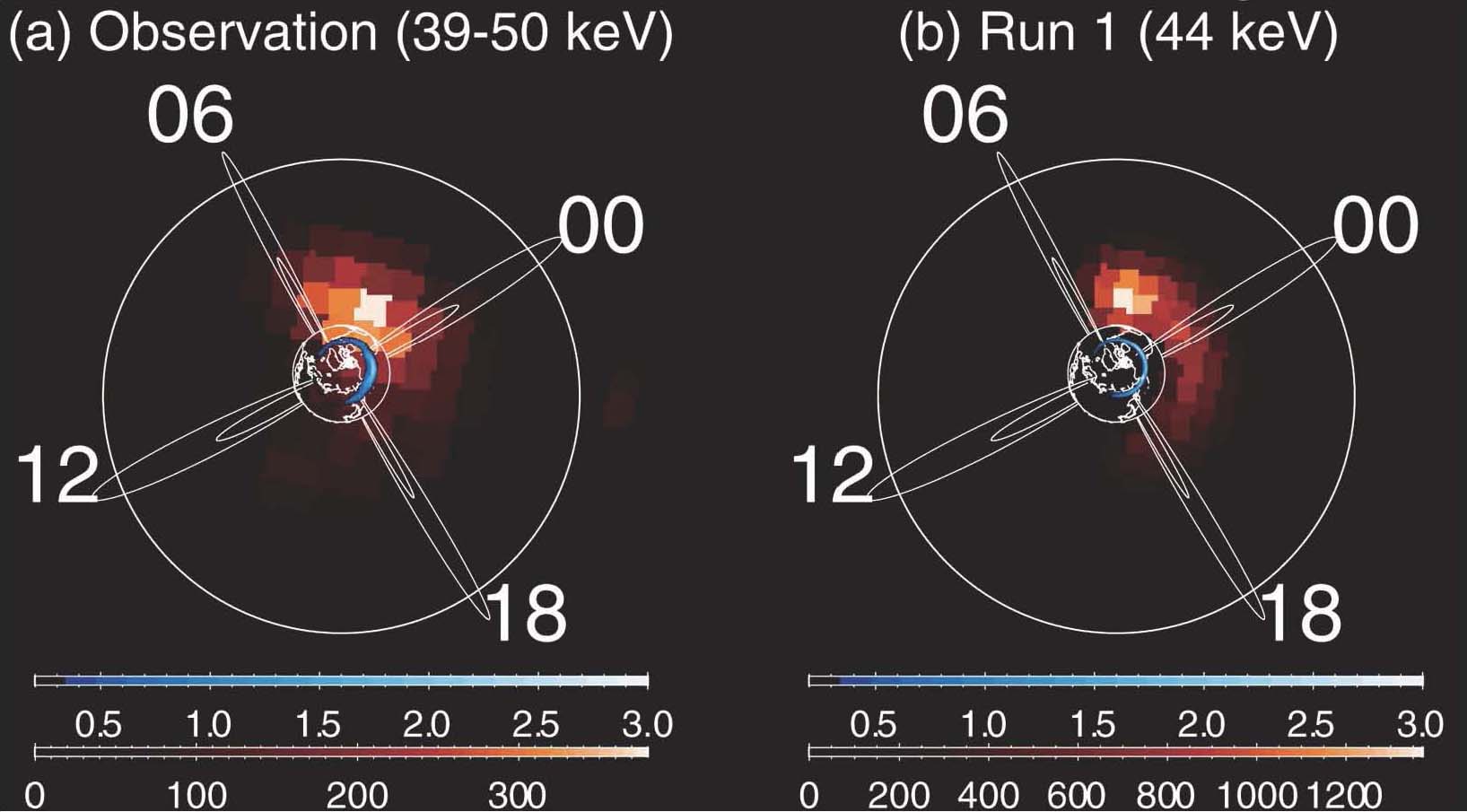GEMSIS-Ionosphere
Inner Magnetosphere-Ionosphere Coupling
During magnetic storms, energetic particles are accumulated in the inner magnetosphere, resulting in the development of the ring current. The ring current is a huge electric current surrounding the Earth. The remnants of the electric current are thought to flow into/away from the ionosphere. In order to cancel out the space charge deposited by the electric current, an additional electric field is developed.
Short-Period Variations of Ionospheric Plasmas

We have succeeded to explain the variation of the storm-time electric field observed by the SuperDARN Hokkaido radar by using simulation that couples the magnetosphere and the ionosphere. We have suggested that the subauroral ionosphere can be a manifestation of the storm-time ring current during magnetic storms.

This figure shows the simulated plasma pressure (ring current) in the magnetosphere. The multiple-layered structures seen in this figure generates the multiple-layered field-aligned current, resulting in the temporal variation of the rapid, westward flow of the plasma in the subauroral ionosphere.
Magnetosphere-Ionosphere Current System during Storms and Substorms
When the interplanetary magnetic field (IMF) is directed southward, the convection electric field intensifies and propagates to the equatorial ionosphere via the polar ionosphere, completing a current circuit composed of the Region-1 field-aligned current and the equatorial electrojet (EEJ). In contrast, when the southward IMF decreases or the IMF turns northward, reversed currents develop at middle and low latitudes; in particular, we note the development of a counter electrojet (CEJ) at the dayside equator. The EEJ current circuit develops during the storm main and substorm growth phases, whereas the CEJ circuit develops during the storm recovery and substorm expansion phases. These two current circuits appear alternately in the traditional DP2 magnetic fluctuations. Consequently, these are fundamental current circuits in the magnetosphere-ionosphere coupled system.
Response of Convection Electric Fields in the Magnetosphere to Interplanetary Magnetic Field Orientation Change
The transient response of convection electric fields in the inner magnetosphere to the IMF southward turning was investigated using in situ electric field observations by the CRRES and Akebono spacecraft. Electric fields earthward of the inner edge of the electron plasma sheet responded simultaneously with the changes in the ionospheric electric fields that indicated the arrival of the first signal related to southward turning. Coordinated observations of the electric field by the CRRES and Akebono spacecraft revealed a simultaneous increase in the dawn-dusk electric field over a wide region of the inner magnetosphere. This indicates that the southward turn of the IMF initiates simultaneous (less than 1 min) enhancements in the ionospheric electric fields, convection electric fields in the inner magnetosphere, and the ring or tail current, and region-2 field-aligned currents. In contrast, the convection electric fields in the electron plasma sheet did not appear to respond quickly. A statistical study using 161 events of IMF orientation change in 1991 confirmed a prompt response (within 5 min for 80% of events earthward of the electron plasma sheet), whereas a long time lag (more than 30 min) was identified in the electric fields in the electron plasma sheet.
Reference: Nishimura et al., JGR, 2009
Rapid Decay of Ring Current and Formation of the Main Oval of Proton Aurora
A rapid decay of the storm-time ring current was investigated by means of a simulation using realistic magnetic field and electric field models with pitch angle scattering due to the field line curvature (FLC) together with the charge exchange and adiabatic cone loss. When all three loss processes were included, the Dst (Sym-H) index showed rapid recovery, with an e-folding time of ~6 h, which is consistent with observations. Precipitating proton flux agreed fairly well with the data based on the proton aurora observed by the IMAGE satellite. Fairly good agreement between the simulation and observations may imply that FLC scattering is sufficient to account for the rapid recovery of the ring current as seen by Dst (Sym-H).

 Japanese
Japanese